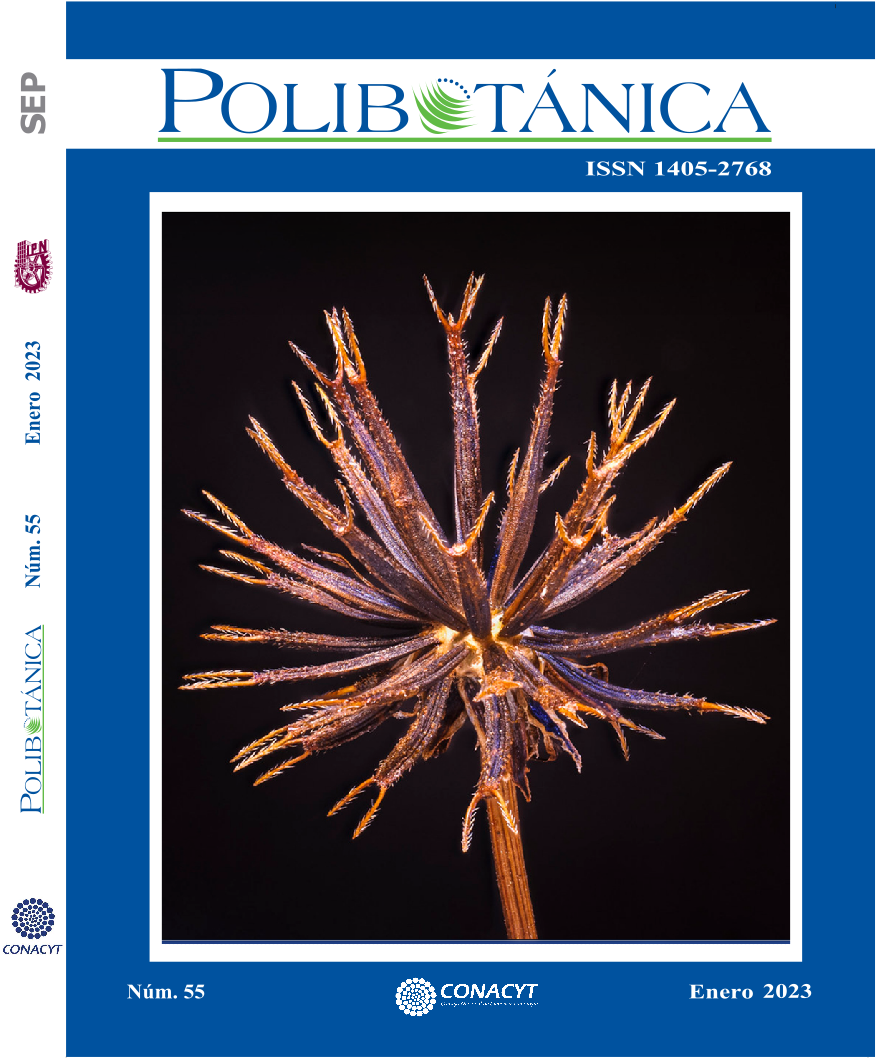Cultural significance of medicinal plants amongst Mochó and Kakchikel ethnic groups of the State of Chiapas, Mexico
DOI:
https://doi.org/10.18387/polibotanica.55.12Keywords:
Biodiversity, health services, diseases, botanical knwoledge, ethnomedicineAbstract
Medicinal plants have had worldwide cultural importance because of their use and preservation in rural communities and urban areas. The aim of this research was to determine the cultural significance that Kakchikel and Mochó ethnic groups, inhabitants of the Sierra Mariscal estate of Chiapas, give to their medicinal plants. A qualitative and quantitative approach was used with direct interviews and a questionnaire. The data provided by the respondents was used to build up a Microsoft Excel® database for descriptive statistics to estimate the number of plants used per illness, grouped according to the International Statistical Classification of Diseases and Related Health Problems of the WHO. Similarity of illnesses amongst ethnic groups was determined adopting the Jaccard index, and the Significant Use Level (TRAMIL) or cultural value per plant species was evaluated as well. Both ethnic groups are registered for some official or private medical services, but they prefer using medicinal plants, regardless of their literacy level. The Mochó ethnic group reported 93 illnesses and the Kakchikel 74, classified into 13 diseases groups according to the WHO, having a 28.5% of similarity index. Ten out of 167 illnesses were reported as the most common ailments, such as: coughing, headache, diarrhea, fever, flu, stomachache, diabetes, kidneys ailments, gastritis and wounds. From 209 as total of medicinal plants, the Mochó reported using 123 and the Kakchikel 86, from which 16 and 14 species had cultural significance respectively. Most used medicinal plants are Fennel (Foeniculum vulgare Mill.), common rue (Ruta graveolens L.) and verbain (Verbena litoralis Kunth.).
References
Benoit, J. (2008). Formas de transformación del conocimiento de la medicina tradicional en los pueblos nahuas del municipio de Hueyapan, Sierra Norte de Puebla. Cuicuilco. 15(44): 181-196.
Bermúdez, A., y D. Velásquez (2002). Etnobotánica medica de una comunidad campesina del estado Trujillo, Venezuela: un estudio preliminar usando técnicas cuantitativas. Revista de la Facultad de Farmacia. 44: 2-6.
Bermúdez, A., M.M.E. Oliveira y D. Velásquez, (2005). La investigación etnobotánica sobre plantas medicinales: una revisión de sus objetivos y enfoques actuales. Interciencia. 30(8): 453-459.
Berry, J. W. (2003). Conceptual approaches to acculturation. In K. Chun, P. Balls-Organista, & G. Martin (Eds.), Acculturation: Advances in theory, measurement, and applied research (pp. 17-37). Washington DC: American Psychological Association Press. http://dx.doi.org/10.1037/10472-004 https://psycnet.apa.org/doiLanding?doi=10.1037%2F10472-004.
DeWalt, K. M. y DeWalt, B. R. (2002). Participant observation: a guide for fieldworkers. Walnut Creek, CA: AltaMira Press. https://books.google.com.mx/books?id=p1wcO3UNXQ4C&printsec=frontcover&hl=es&source=gbs_ge_summary_r&cad=0#v=onepage&q&f=false.
Germosén-Robineau, L. (1995). Investigación Científica y Uso Popular de Plantas Medicinales en el Caribe. San Andrés Isla, Colombia. Universidad de Antioquía. pp. 696.
Gheno-Heredia, Y. A., G. Nava-Bernal., A. R. Martínez-Campos y E. Sánchez-Vera. (2011). Las plantas medicinales de la organización de parteras y médicos indígenas tradicionales de Ixhuatlancillo, Veracruz, México y su significancia cultural. Polibotánica 31: 199-251.
Giddens, A. (2000). Cultura, Sociedad e Individuo. Capítulo 2. En: Giddens, A. Sociología Segunda reimpresión (pp. 3-33).
Hitziger, M. (2016). Mayan phytotherapy in Guatemala: a transdisciplinary study for ethnographic documentation and local empowerment. Tesis doctoral. universidad de Eth Zurich.
Hurtado, N. E., C. Rodríguez y A. Aguilar. (2006). Estudio cualitativo y cuantitativo de la flora medicinal del municipio de Copándaro de Galeana, Michoacán, México. Polibotánica 22: 21-50.
Instituto Nacional de Estadística y Geografía. (2012). Estadísticas de Chiapas, México. INEGI.
Kawulich, B. B. (2005). La observación participante como método de recolección de datos. Qualitative Social Research. 6 (2): 1-32.
Kigen, G., Ronoh, H.K., Kipkore, W., y Rotich, J.K. (2013). Current trends of Traditional Herbal Medicine Practice in Kenya: A review. The African Journal of Pharmacology and Therapeutics, 2(1): 32-37.
Magaña-Alejandro, M.A., Gama-Campillo, L. Ma. y Mariaca-M, Ramón. (2010). El uso de las plantas medicinales en las comunidades Maya chontales de Nacajuca, Tabasco, México. Polibotánica 29: 213-262.
Nwachukwu, C.U., Umeh, C.N., Kalu, I.G., Okere, S. y Nwoko, M. (2010). Identification and traditional uses of some common medicinal plants in Ezinihitte Mbaise LGA, of Imo State, Nigeria. Report and Opinion. 2(6):1.
Okello, S. V., Nyunja, R. O., Netondo, G. W., y Onyango, J. C. (2009). Ethnobotanical study of medicinal plants used by Sabaots of Mt. Elgon Kenya. African journal of traditional, complementary, and alternative medicines. 7(1), 1–10. https://doi.org/10.4314/ajtcam.v7i1.57223
Owuor, B.O., Mulemi, B.A. y Kokwaro, J.O. (2005). Indigenous snake bite remedies of the Luo of western Kenya. Journal of Ethnobiology. 25(1):129-41.
Pascual-Casamayor, D., Pérez-Campos, Y.E., Morales-Guerrero, I., Castellanos-Coloma, I., y González-Heredia E. (2014). Algunas consideraciones sobre el surgimiento y la evolución de la medicina natural y tradicional. MEDISAN.18(10):1467-74.
Programa Regional de Desarrollo 2013-2018. (2014). Programa Regional de Desarrollo formulado en el Marco del Comité de Planeación para el Desarrollo Regional (COPLADER). Tuxtla Gutiérrez, Chiapas. Región XI Sierra Mariscal. pp.71.
Restrepo, E. 2016. Etnografía: alcances, técnicas y éticas. Pontificia Universidad Javeriana, Bogotá, Facultad de Ciencias Sociales. Envión editores.
Sotero-García, A. I., Gheno-Heredia, Y. A., Martínez-Campos, A. R. y Arteaga-Reyes, T. T. (2016). Plantas medicinales usadas para las afecciones respiratorias en Loma Alta, Nevado de Toluca, México. Acta Botánica Mexicana. (114): 51-68.
Taddei-Bringas, G. A., Santillana-Macedo, M. A., Romero-Cancio, J. A., Romero-Téllez M. B. (1999). Aceptación y uso de herbolaria en medicina familiar. Salud Pública de México. 41(3): 216-220.
Toscano-González, J. Y. (2006). Uso tradicional de plantas medicinales en la vereda San Isidro, municipio de San José de Pare-Boyacá: un estudio preliminar usando técnicas cuantitativas. Acta Biológica Colombiana. 11(2): 137-146.
Trigueros-Vázquez I. Y., Bautista-García,G., Cessa Reyes, V. y García-Sánchez, A. I. (2018). Uso de plantas medicinales en Paso Serrano, Manlio Fabio Altamirano, Veracruz: un estudio de caso. En: Vinay, V. J. C., V. A. Esqueda E., O. H. Tosquy V., R. Zetina L., A. Ríos U., M. V. Vázquez H., A. L. Del Angel P. y C. Perdomo M. (comps.). MEMORIA XXXI. Reunión Científica-Tecnológica, Forestal y Agropecuaria, Veracruz. INIFAP, CP, UACH, INAPESCA, UV, TecNM. Medellín, Ver., México. (Año 2, Núm. 1: 1352).
Villarreal-Ibarra, E. C., García-López, E., López, P. A., Palma-López, D. J., Lagunes-Espinoza, L. del C., Ortiz-García, C. F., y Oranday-Cárdenas, A. (2014). Plantas útiles en la medicina tradicional de Malpasito-Huimanguillo, Tabasco, México. Polibotánica, 37, 109–134. https://www.redalyc.org/pdf/621/62129967007.pdf
Villoro, L. (1982). Creer, saber y conocer. México: Siglo XXI..
Yazdanshenas, H., Shafeian, E., Nasiri, M., y Mousavi, S. A. (2016). Indigenous knowledge on use values of Karvan district plants, Iran. Enviromental Development and Sustainabilty. 18(4): 1217-1238. https://link.springer.com/article/10.1007/s10668-015-9698-y
Zambrano-Intriago, L. F., Buenaño-Allauca, M. P., Mancera-Rodríguez, N. J., y Jiménez-Romero, E. (2015). Estudio etnobotánico de plantas medicinales utilizadas por los habitantes del área rural de la Parroquia San Carlos, Quevedo, Ecuador. Revista Universidad y Salud. 17(1): 97-111.
Downloads
Published
Issue
Section
License

Polibotánica by Departamento de Botánica de la Escuela Nacional de Ciencias Biológicas del Instituto Politécnico Nacional se distribuye bajo una Licencia Creative Commons Atribución-NoComercial-CompartirIgual 4.0 Internacional.




















